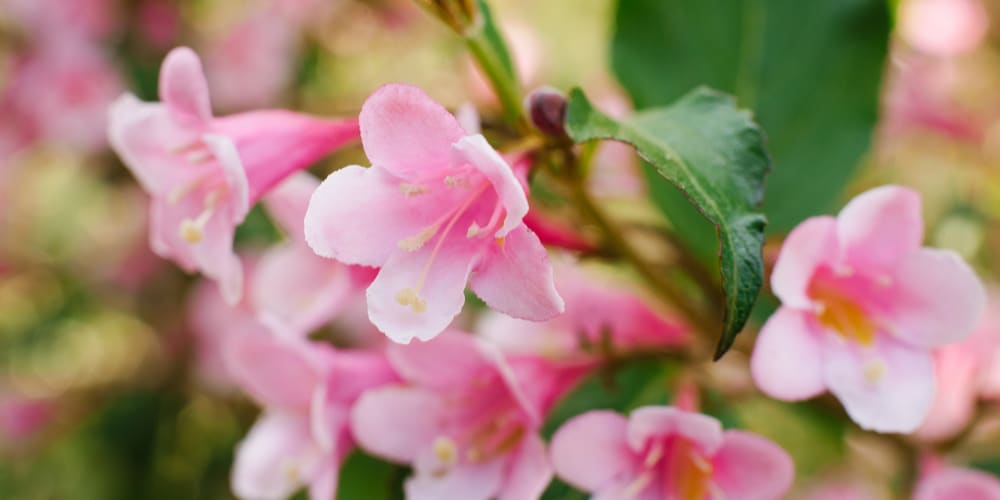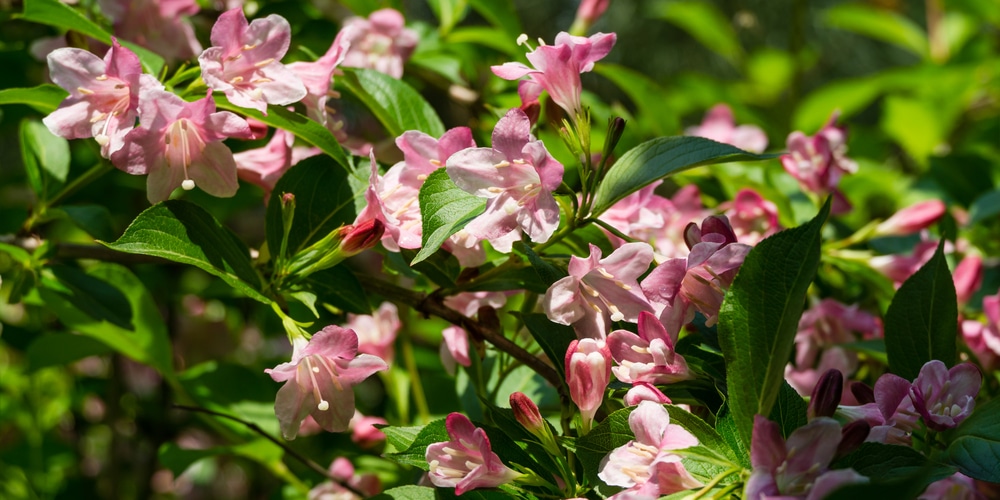The ‘Polka’ shrub is a compact cultivar of the Weigela species with pink, funnel-shaped flowers appearing in late spring to fall.
| Botanical Name | Weigela florida |
| Common Name | ‘Polka’ Weigela |
| Plant Type | Perennial |
| Flower Color | Light pink flowers with yellow throats |
| Size When Mature | 60 inches |
| Bloom Time | Late spring |
| Sun Requirements | Full sun |
| USDA Hardiness Zones | 4 to 9 |
| Soil PH Range | 5.5 to 7.5 |
| Soil Type | Well-drained, acidic, slightly alkaline |
| Water Needs | Moderate |
| Native Area | Japan, Korea and northern China |
What you Need to Know About Polka Weigela
Polka Weigela belongs to the Weigela florida species and sports a rounded and dense, yet relatively short form. ‘Polka’ is a deciduous shrub with multiple stems, with forest green foliage giving way to funnel-shaped and fragrant blooms that are light pink and white in color. The flowers attract beneficial wildlife and tend to show up in late spring all the way through fall.
Weigela florida can grow in any soil condition and is safe to have around pets and children.
How to Care for Polka Weigela
Here’s everything you need to know about growing and caring for a thriving Polka Weigela
Light
‘Polka’ weigela should be planted in no less than full sun. The flowering shrub can compromise and settle for dappled shade and partial sun at the expense of fewer blooms and vigor. If you want a healthy-looking Weigela Florida with a shower of pink and white ‘polka dots’, then you should plant it where it can get a minimum of 6 hours of direct sunlight.
Light and watering requirements for weigela adjust depending on the climate. In hotter regions, shade from the afternoon sun may be needed, as well as supplemental watering. ‘Polka’ can grow in containers and be displayed in south-facing windows, or moved outside so it can get essential sunlight.
Water and Soil Needs
To grow Polka Weigela and make the most of the plant in your landscape, you’ll need to meet its soil and watering needs. The Weigela florida species can grow in any soil as long as it’s well-drained and can hold a fair amount of moisture. pH can be anywhere from 5.5 to 7.5, but more importantly, the shrub’s growing medium should contain plenty of nutrients in order to grow to its full potential.
Amend your usual garden soil or potting mix with plenty of organic compost. As far as watering is concerned, you should keep the soil relatively moist and not allow the medium to completely dry out. ‘Polka’ likes to be constantly watered but it doesn’t like getting waterlogged, which explains the importance of a well-draining medium.
Temperature Requirements
Weigela shrubs in general thrive in USDA zones 4 through 9. ‘Polka’ wants full sun and can take warm temperatures well as long as the plant gets enough water.
Fertilizer
The best fertilizer to use on a Polka Weigela is a balanced and slow-release fertilizer.
Your Polka Weigela can benefit from a yearly feeding as more nutrients equates to bigger and more pink and white flowers. Adding organic compost and manure during the shrub’s growing season is usually enough to support a spectacular show, but you can give it more nutrients in the form of a slow-release product.
A single dose per growing season should be enough for a Polka Weigela shrub. Opt for fertilizers that are formulated for flowering shrubs and make sure to follow the instructions on the label.
Common Diseases
Polka Weigela is fairly resistant to most pests and diseases, but a severe infestation or too much neglect can lead to fungal diseases such as black spot, powdery mildew and rust. Aphids, mealybugs and spider mites may also visit your weigela, especially if it’s stressed or weakened.
The best way to avoid these diseases is to observe proper watering and direct the spout or hose at the base of the shrub. Don’t wet the leaves if you’re watering in the late evening.
Polka Weigela Propagation
Weigela florida can be propagated via early cuttings or hardwood cuttings with a high rate of success. Seed propagation may also be done but it’s not recommended because it takes longer.
You can take either mature or early growth cuttings in late summer or early fall and plant them in a moist medium. To increase your chances you should water your weigela first the day before. Using a sharp and sterilized pair of garden shears, cut stems that are 4 to 6 inches in length and remove the lower leaves. Dipping the ends in rooting hormone is optional.
Keep the soil moist and wait several weeks, and the cuttings should have small growth and produce roots. Plant in a larger container and treat it as a new weigela shrub.


